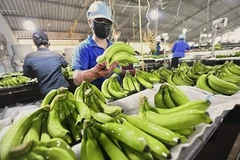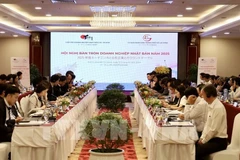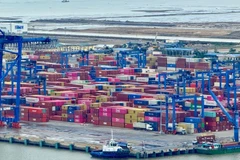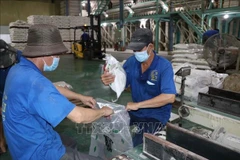Addressing a conference held in Hanoi ,Deputy Minister of Agriculture and Rural Development Vu Van Tam said thefocus of the fisheries industry in the next five years (2011-15) wouldbe to ensure output and export value, food safety and improved earningsand living conditions for fishers.
The fisheriessector, including both fishing and aquaculture, will also focus ondeveloping the processing industry to raise product value and improvethe competitiveness of Vietnamese fishery products.
The fisheries sector, has in the last three decades, recorded a highgrowth rate, generating jobs for many people in the country, especiallyin coastal areas.
Vietnam 's seafood exports increased strongly in the 2001-10 period both in volume and value.
In 2001, the country exported 375,000 tonnes of seafood, earning 1.78billion USD. Last year, the country earned 4.94 billion USD from 1.34million tonnes of seafood exports.
However, thesector faces many challenges that threaten its sustainable development,such as exhausting near-shore natural resources due to overfishing, manyparticipants said at the conference.
Thedevelopment of aquaculture without a proper plan has resulted in lowefficiency and adversely affected the environment, Tam said, adding thatrelevant agencies should cooperate with local authorities to improveefficiency.
The lack of a long-term strategy foraquatic breeding development is another limitation of the industry, saidTran Dinh Vinh, head of the sub-department of Quality Management andFisheries Resources Protection under the HCM City Department ofAgriculture and Rural Development.
Tran Cao Muu,general secretary of the Vietnam Fisheries Society, agreed with theassessments, saying that the aquatic breeding industry has notprogressed as expected due to scattered investment and overlaps inmanagement.
As a result, the country now producesonly basa fish fry, and imports other breeds including key species suchas sugpo prawn and white-legged shrimp, Vinh said.
Muu said the country must reduce the number of near-shore fishingvessels, take measures to support these fishermen in changing theirvocation and focus more on developing aquatic breeding.
Phan Minh Quang, deputy director of the Bac Lieu Department ofAgriculture and Rural Development, said the Government should investmore in improving infrastructure to facilitate aquaculture.
The Government should also adopt a policy to support fishermen whoshift from coastal fishing to offshore fishing, he said.
Training human resources is very important to further develop theindustry, said Nguyen Van Viet, rector of Fisheries College .
The country's fisheries sector aims to achieve annual export growth of8-10 percent until 2015, with export revenues estimated to reach 6.5billion USD by 2015, according to a five-year draft plan.
The plan envisages an average annual growth in fisheries output of 2.66 percent.
In the coming years, besides seeking new export markets and boostingexports to South Africa and Middle East, the sector will furtherstrengthen its presence in the key export markets of the EU, the US andJapan, Tam said./.
























